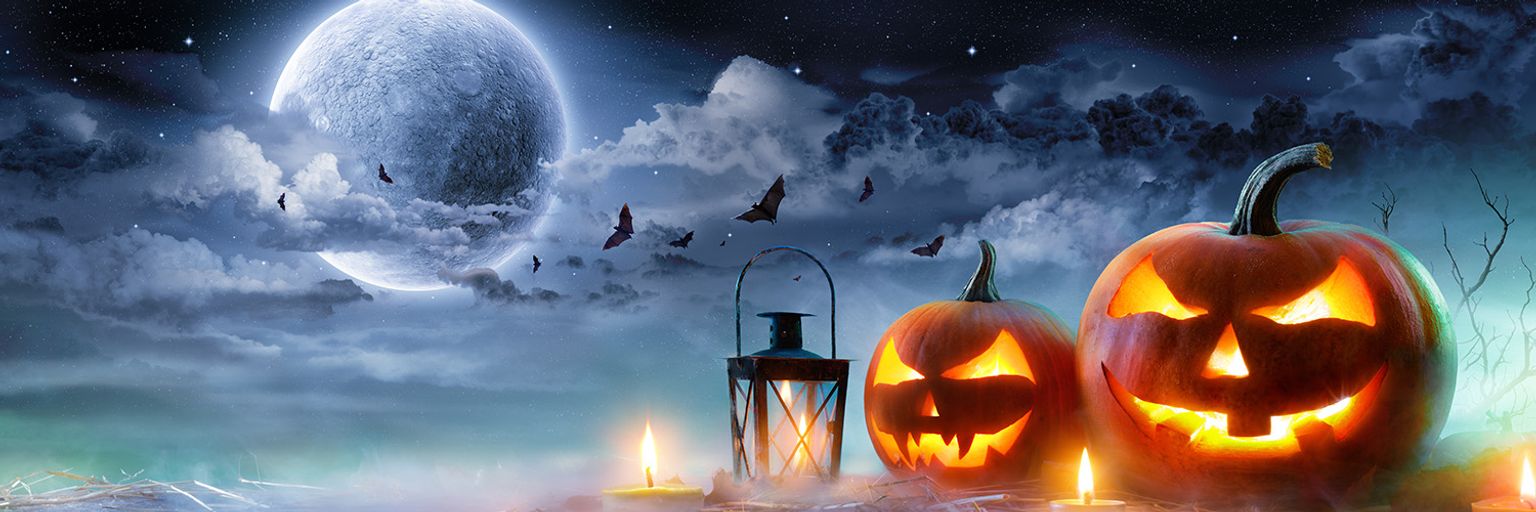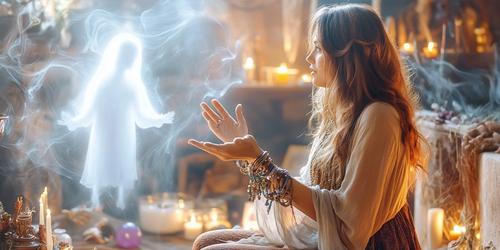
To pay for your reading on your telephone bill, simply call
Instantly message our featured psychics online via psychic messenger.
Click to start
Register now to start your reading online. PSYCHIC MESSENGER- Cheapest psychic service in the UK
- Our readers are available 24/7
- 100% confidential service
- In-depth, concise, personal readings
- Thousands of 5* reviews
Published 29/01/2024 by Sarah Lutterloch
Spiritual Meaning of Halloween Unveiled
Halloween, or All Hallows' Eve, is celebrated annually on October 31 in countries worldwide. For many, this holiday is a time for dressing up in costumes, trick-or-treating, and attending spooky parties—however, the roots of this holiday date back to ancient Celtic traditions.
The ancient Celts believed that the boundary between the living and the dead was blurred on this night, allowing spirits to roam freely.
Historical Roots of Halloween
While the origins of Halloween can be traced to the Celtic festival of Samhain, which was held on the night of October 31st, there are a plethora of fascinating details about the tradition that most people are not aware of. Samhain, which means "summer's end" in Gaelic, was a time when the veil between the living and the dead was thought to be at its thinnest. This allowed the spirits of deceased loved ones, as well as malevolent entities, to cross over more easily into the physical realm.
The Celts believed that on this night, the veil between the living and the dead was at its thinnest, creating an opportunity for spirits to cross into the living world.
To ward off these otherworldly visitors, the Celts would light bonfires and dress up in ghoulish costumes, hoping to scare away unwanted visitors. They also left food and drink offerings outside their homes to appease the spirits and keep them from causing mischief.
As Christianity spread throughout Europe, many pagan traditions were incorporated into the new religion, including celebrating Samhain. Pope Gregory III declared November 1 as All Saints' Day, or All Hallows' Day and October 31 became known as All Hallows' Eve, later shortened to Halloween.
Samhain Traditions and Their Influence
Samhain is a traditional Celtic festival celebrated from sunset on October 31 to sunset on November 1. It is often called the "Festival of the Dead" and is one of the four significant Gaelic seasonal festivals, along with Imbolc, Beltane, and Lughnasadh.
The ancient Celts celebrated Samhain as a time when the veil between the world of the living and the dead was believed to be at its thinnest.
One of the most prominent Samhain traditions was the lighting of bonfires. These fires were seen as a symbol of the sun's warmth and light, which would help to keep the community safe and provide protection from the dark and cold winter months. The fires were also believed to be a beacon for lost souls, guiding them back to their loved ones and the world of the living.
Another Samhain tradition was the wearing of costumes and masks. People would dress up in scary or grotesque costumes, often representing the spirits of the dead. This belief was rooted in the ancient Celtic belief that the spirits of the dead would return to the world of the living on Samhain and that by dressing up and wearing masks, they could blend in with the spirits and avoid being taken by them.
Samhain is often credited with being the origin of Halloween, which is now a worldwide holiday celebrated on October 31. Many of the customs associated with Halloween, such as trick-or-treating, carving pumpkins, and wearing costumes, have their roots in the ancient Samhain traditions.
Additionally, the Christian holiday of All Saints' Day, celebrated on November 1, is thought to have been influenced by Samhain and the Celtic belief in the afterlife.
Halloween and the Veil Between Worlds
The concept of the veil between worlds is deeply rooted in many cultures and religions. In ancient Egyptian mythology, the god Anubis would weigh a person's heart against a feather to determine their fate in the afterlife. In Buddhism, the Bardo Thodol, or the Tibetan Book of the Dead, describes a series of stages a person goes through after death as they navigate different realms of existence.
The concept of the veil between worlds is one of great significance in the field of psychic readings. The veil refers to the separation between the physical world and the spiritual realm, which is believed to be inhabited by departed souls and other entities.
This separation is viewed as a barrier that prevents us from fully accessing the spiritual realm and the wisdom and guidance it offers. However, it is believed that specific individuals possess the ability to penetrate this veil and communicate with spiritual entities using their heightened intuitive senses.
The difference between Halloween and Samhain may seem minor, but understanding the difference is crucial. Samhain is the event that gave birth to Halloween, and it represents a meaningful moment of connection, contemplation, and reverence.
What Is the Spiritual Significance of Halloween?
The spiritual significance of Halloween is that it was believed that on this day, the veil between the worlds of the living and the dead became thin, allowing for the spirits of the ancestors and other supernatural beings to pass through and interact with the living.
As Christianity spread throughout the world, Halloween was eventually incorporated and transformed into the holiday known as All Saints' Day or All Hallows' Day, observed on November 1st. The eve of All Saints' Day became known as All Hallows' Eve, later known as Halloween.
On a spiritual level, Halloween represents a time for reflection, letting go of the past, and embracing the approach of the darker months. It’s a time to honour and reconnect with our ancestors, who have passed on to the afterlife and show gratitude for their lives and the wisdom they imparted.
Some people believe that during Halloween, they can communicate with spirits through divination practices such as Ouija boards, tarot card readings, and seances. These activities are not recommended as they can be dangerous, and it is important to approach them with caution and respect for the spiritual realm.
Halloween Rituals and Practices
Halloween is a time-honoured holiday celebrated annually on the night of October 31. Halloween rituals and practices have thus developed over time to ward off evil spirits, honour the deceased, and celebrate the arrival of the harvest season.
Popular Halloween Rituals
A popular practice during Halloween is carving pumpkins into spooky faces or creatures. According to Irish folklore, Stingy Jack was known for his cunning ways and his love for trickery.
One day, as he was wandering through the countryside, he stumbled upon the devil himself. Seeking to test his wit, Jack challenged the devil to a competition to see who could climb a nearby tree faster. The devil, confident in his ability, quickly agreed and began to scale the tree with ease.
As the devil neared the higher branches, Jack sprang into action. He carved a cross into the trunk of the tree, trapping the devil up there. The devil, enraged and humiliated, pleaded with Jack to let him down. But Jack, with his sly smile, made the devil promise to never come after him or claim his soul when he died.
Another common tradition during Halloween is dressing up in costumes. This practice initially served to disguise oneself from malevolent spirits that were thought to be roaming around during Samhain, but it has since become a fun and creative way to celebrate the holiday. Popular costumes include ghosts, witches, zombies, and characters from movies and TV shows.
Trick-or-treating is another cherished Halloween practice that involves children going around their neighbourhoods in costumes and collecting candy from neighbours who leave out bowls of sweets. As Halloween became more popular in the US during the 20th century, trick-or-treating became more prevalent and eventually became the candy-filled tradition today.
Lastly, many people hold Halloween parties, decorate their homes with scary props, and offer tasty treats and drinks. This provides an opportunity for friends and family to come together, have fun, and indulge in the spooky spirit of Halloween. Halloween rituals and practices are rooted in rich cultural and historical traditions and continue to bring excitement to people of all ages.
Connecting With the Spirit Realm
Rituals and practices enabling us to connect with the spirit realm have existed in cultures and civilisations. These practices involve various techniques and beliefs that facilitate communication with spirits and other entities in a realm beyond our physical existence.
One of the most common practices is meditation, a technique used to connect with the spirit realm for centuries. Meditation enables practitioners to transcend their physical bodies and focus on the spiritual realm. Meditators can reach a state of consciousness through deep breathing and visualisation to communicate with spirits and other entities.
Other rituals and practices include the use of natural herbs and substances, such as ayahuasca, peyote, and psilocybin mushrooms. Many cultures have used these substances to connect with the spirit realm. In many cases, they are consumed in a ceremonial context, with the guidance of experienced spiritual guides or shamans.
Another practice that has been used to connect with the spirit realm is the use of divination tools such as tarot cards, crystals, or runes. Divination tools help practitioners tap into their intuition and receive messages from the spirit realm. By interpreting the symbols and messages through these tools, psychics can gain deeper insights and understanding of the spirit realm.
Protective Measures
Historically, rituals and practices have been conducted using various tools and symbols to stimulate spiritual activity. These include candles, incense, crystals, and amulets, among others. These items are believed to encourage spirits to communicate with the living, bring good luck, and provide spiritual protection against evil.
In some cultures, protective measures are essential in spiritual practices. This includes taking precautions against negative energies that may harm the living. Protective measures like using talismans and holy water, smoking out negative energies using sage, or creating charms and spells are believed to ward off harmful spirits and negative energies.
Psychic Readings
Psychic readings have come a long way from their origins in ancient civilisations, where they were considered a sacred tradition. The advancements in technology have brought psychics online, making them accessible to anyone in the world. These psychic readers have gained immense popularity among all walks of life due to their growing inclination towards nature and holistic approaches to life.
The value of consulting a psychic reader is immeasurable. Psychics are uniquely gifted to tap into the energy patterns of a person's life and read their subconscious, allowing them to see things that may have been obscured or overlooked. This fresh perspective on life's obstacles can empower individuals to shed light on their lives and look to resolve their differences with confidence and determination.
Therefore, it is no surprise that Trusted Psychics has consistently recommended live readers as the most effective way of seeking guidance. With their wealth of knowledge, expertise, and experience, these professionals are the key to unlocking a wealth of hidden potential in one's life. Whether facing health issues, relationship problems, or career challenges, Trusted Psychics offers the perfect platform to access quality readings from skilled and reputable psychic readers.
FAQs
Why Do We Celebrate Halloween on October 31?
Halloween, a holiday celebrated annually on the night of October 31, has a rich historical and cultural background. The origin of this spooky holiday is deeply rooted in its association with the ancient Celtic festival of Samhain. The Celts believed that on October 31, the boundary between the living and the dead blurred, which allowed ghosts and supernatural beings to roam the earth.
The significance of celebrating Halloween on October 31 has been preserved. This date was chosen because it corresponds with the Christian holy day of All Saints' Day, which is also known as All Hallows' Day.
The day before All Saints' Day became known as All Hallows' Eve, eventually leading to Halloween. The Christian Church adopted the observance of Halloween on this date as a way of co-opting the traditional pagan festival of Samhain and giving it a Christian focus.
Why Do We Celebrate Halloween With a Pumpkin?
The pumpkin, undoubtedly, is one of the most recognised symbols associated with the celebration of Halloween. As we delve deeper into the origins of this ancient tradition, we discover that carving pumpkins, also known as "Jack-o'-lanterns," is a centuries-old custom that originated from an Irish legend.
The mythological tale revolves around Stingy Jack, a notorious trickster who once duped the Devil himself. According to the legend, Jack, a man known for his greed and deceit, managed to convince the Devil to climb up a tree to pluck some fruit, only to carve a cross sign at the bottom of the tree, thus trapping the Devil.
What Is Halloween Supposed to Mean?
Halloween is meant to be a celebration of both life and death, where people can confront their fears and anxieties through entertaining and spooky activities. It has become an important and widely celebrated holiday, which continues to evolve and incorporate new cultural traditions.
Contact Trusted Psychics live psychic readers, just a phone call away or contact the same fantastic expert readers on live messenger services.
How To Contact A Trusted Psychic
Phone a live Psychic 24 hours a day
View all our live phone psychic and tarot readers online.
View All Live readersMessage a live Psychic 24 hours a day:
View all our live messenger psychic and tarot readers online.
launch messengerRecent Articles From the Trusted Psychics Blog

Types of Psychic Mediums and Their Abilities
In this article, we look at types of Psychic Mediums & their abilities. From psychics who use their Clair gifts to Mediums who connect directly with spirit.

Can Mediums Really Speak to the Dead Video
Medium readings offer a way to reconnect with your loved ones who’ve crossed over. In this video, we explore what mediumship is & why people use it for healing.

Cheap Medium Readings Video
Are you curious about medium readings and how they work? In this video, we break down what mediumship is and how mediums connect with the spirit world.

Can Mediums Really Speak to the Dead?
This article from Trusted Psychics delves into the advantages of medium readings and examines whether Mediums can speak with the dead and the tools they use.

What Is a Medium Reading?
Discover what a medium reading is, its history, how it works, and what to expect. Explore benefits, types, and tips for a meaningful experience.

Dreams About Dying
Interpret dreams about dying with our insights and explore the meaning behind these profound experiences from the experts at Trusted Psychics.

